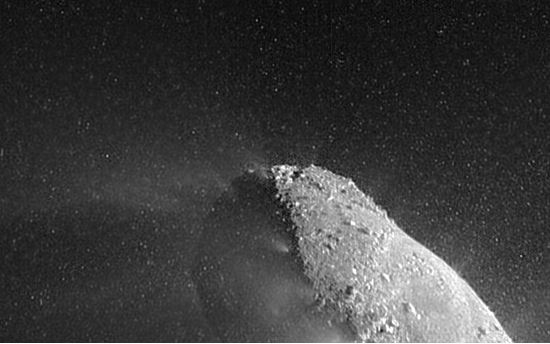This phenomenon was observed for the first time. Hartley 2 is the fifth comet photographed from a relatively short distance

Over the weekend, NASA issued a travel warning to spacecraft to beware of blizzards if they reach Comet Hartley 2.
The Epoxy spacecraft, formerly Deep Impact, photographed the unexpected storm as it passed by the comet's nucleus on November 4 at a distance of about 700 kilometers. Initially, the researchers only identified the hyperactive jets of the comet. The ice core is full of them, these are the springs that spit out carbon dioxide from dozens of sites. A closer look revealed an even greater wonder: the space around the comet's nucleus is filled with chunks of water and ice, some as big as basketballs.
This sharpened image, taken on November 4 during approach, reveals a cloud of ice particles surrounding the comet's active nucleus.
"We haven't seen anything like this until today," says Prof. Mike O'Hearn from the University of Maryland, the lead researcher on the Epoxy mission. "It really came as a surprise to us."
Before the approach flight to Hartley 2, spacecraft approached the bodies of four comets, Halley, Burley, Wilt 2 and Temple-1. None of them were surrounded by "comet snow". The fact that there is no snow on comet Temple-1 is particularly important because it was photographed by the same spacecraft and the exact same instruments, the resolution was also the same, and the cameras that recorded the snow masses floating around Hartley 2 did not discover anything similar around Temple-1.
"This is a completely new phenomenon," says team member Jessica Sunshine from the University of Maryland. "Comet Harty 2 is unlike the other comets we have visited."
The blizzard occupies a spherical volume centered on the spinning core of Hartley 2. The peanut-shaped core is a total of 2 kilometers long from end to end and is tiny compared to the swarm surrounding it. "The width of the snow cloud is a few tens of kilometers, and it would be much longer," says O'Hearn. "We're still not sure how big it is."
Data collected by the infrared spectrometer on board the Deep Impact spacecraft shows without a doubt that the particles are made of water ice. The nodules contain micron-sized ice grains that are loosely connected together in blocks with a diameter of several centimeters to several tens of centimeters.

2 תגובות
What temperatures are we talking about "up there"?
Why is the phenomenon called "snow" if it is stuck in ice?